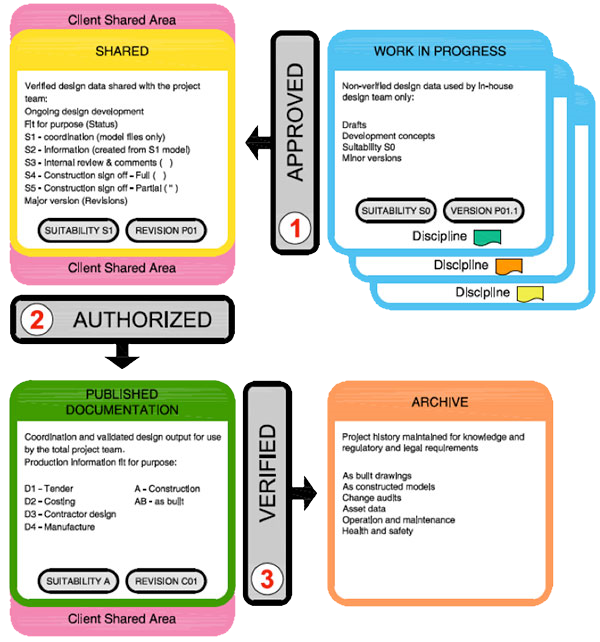A Common Data Environment or CDE is the gold standard for managing project information when multiple parties are involved. The Common Data Environment was originally defined in BS1192:2007, then in PAS 1192-2:2013, finally it has it's own international standard, ISO 19650. It is built on the principle of the controlled sharing of data once certain checks have been made.
The advantages of implementing a CDE Include:
- Ownership of information remains with the originator, although it is shared and reused, only the originator can change it.
- Shared information reduces the time and cost in producing co-ordinated information.
- Any number of documents can be generated from different combinations of model files.

A Common Data Environment has four states that a document can be in.
AEC Hub has colour coded the various state folders to match the information flow diagram. Making easier for new users to understand the system.
Common Data Environment States
The four states of a CDE as defined in BS 1192 are:
- Work in Progress (WIP).
The work in progress state is used for information while it is being developed by its originator or task team. A container in this state should not be visible or accessible to any task team apart from its originator.
- Shared.
The shared state is used for information that has been approved for sharing with the appointing party or with other appropriate appointed parties or task teams. A container in this state should be visible and accessible to them but should not be editable. If editing is required the container should be returned to the work in progress state.
Containers in the shared state should be consulted by all appropriate appointed parties and used to check the coordination, completeness and accuracy of their own information.
The shared state is also used for containers that have been approved for sharing with the project client or with the asset owner/operator and are ready for authorization. A separate information state, client shared, might be used for these containers in cases where the CDE is distributed over different systems or where there are security considerations.
- Published
The published state is used for information that has been authorized for use, either in the construction of a new project or in the operation of an asset.
The project information model at the end of a project or the asset information model during asset operation contains only data and information in the published state or the archived state.
- Archived
The archived state is used to hold a complete record of all superseded containers that have been shared and published during the information management process. A container in the archived state that was previously in the published state represents information that might previously have been relied on for more detailed design work, for construction or for asset management.
AEC Hub and the CDE
When building AEC Hub we realised that implementing a system of controlling the flow of information on a project was vital. We recognised the increasing importance of a implementing a CDE as every project we were involved in had this requirement.
AEC Hub was built with a Common Data Environment built in, in fact AEC Hub is the only CAD and BIM Collaboration platform with this functionality built in as standard.